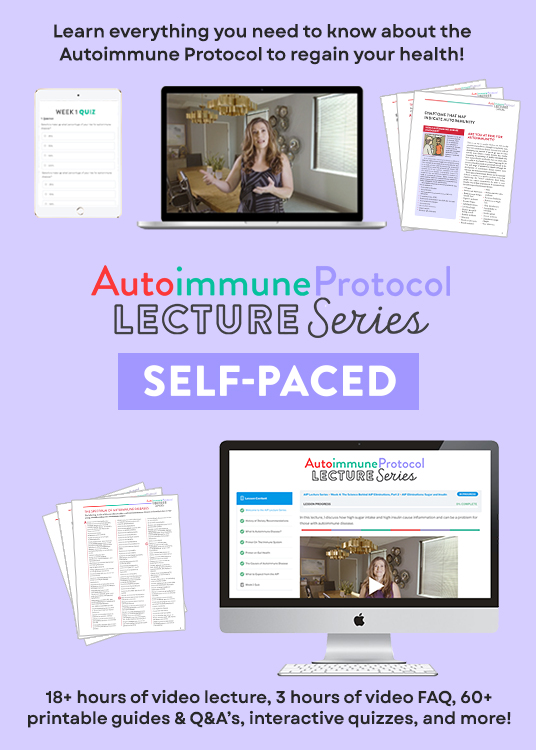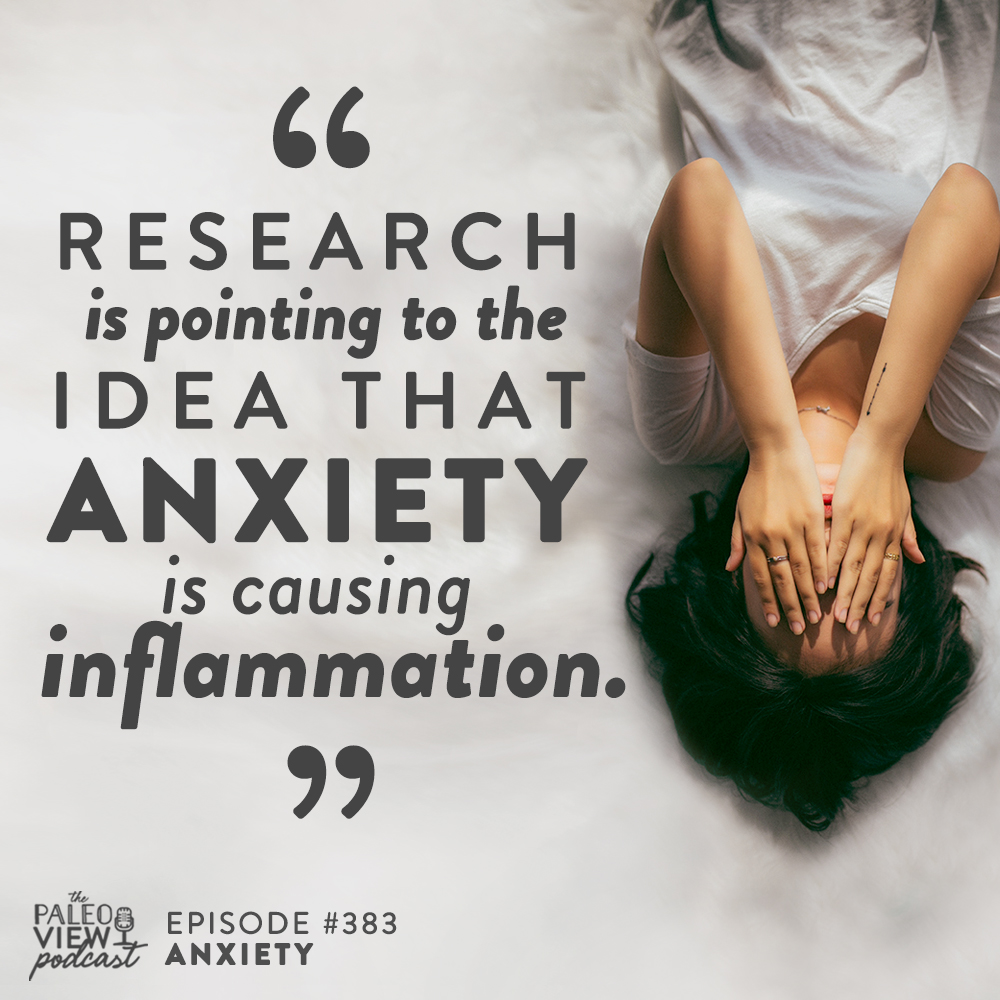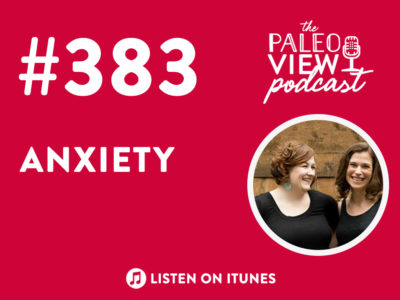On this week’s show, Stacy and Sarah answer a listener’s question about generalized anxiety. What causes the kind of anxiety symptoms that arise without an antecedent or anticipation of a negative event? Is there a link to inflammation and autoimmune conditions? And what can we do to reduce the symptoms of anxiety? All of this and more in episode 383!
If you enjoy the show, please review it on iTunes!
The Paleo View (TPV), Episode 383: Anxiety
Welcome back to The Paleo View, episode 383. (0:40)
We are talking about anxiety this week!
Inspired by a listener’s question, Stacy and Sarah will be discussing generalized anxiety disorder.
It was fascinating for Sarah to research this topic because of her family’s history with generalized anxiety.
Matt has been formally diagnosed with anxiety and does therapy and medication to help him with both his anxiety and his depression.
When Matt and Stacy switched to a paleo diet it did help him reduce his medication.
However, Stacy wants to put it out there that there is nothing wrong with the various things that you need to do to maintain your quality of life.
Between modern medicine and the various treatment options available, please do not have shame or negative emotions associated with any of this.
You are not alone and there is no stigma.
Save 70% Off the AIP Lecture Series!
Learn everything you need to know about the Autoimmune Protocol to regain your health!
I am loving this AIP course and all the information I am receiving. The amount of work you have put into this is amazing and greatly, GREATLY, appreciated. Thank you so much. Taking this course gives me the knowledge I need to understand why my body is doing what it is doing and reinforces my determination to continue along this dietary path to heal it. Invaluable!
Carmen Maier

What Stacy and Sarah are going to talk about today, you have their support and there are people in your life who will support you in making changes so you feel your best as well.
GAD
Kayla reached out and said: I am super curious about what is happening in the body with generalized anxiety. (7:16)
I’m specifically interested in the kind of anxiety symptoms that arise without an antecedent or anticipation of a negative event; the generalized anxiety that appears seemingly out-of-nowhere, bringing chest tightness, fast heartbeat, and stomach unease on a perfectly lovely day.
I’ve noticed that anxiety is a common secondary diagnosis for many with autoimmune disease (especially digestive ones!), and I’m wondering if there’s a certain inflammatory process tied to anxiety?
As always, thank you so much for all that you do! I’m not exaggerating when I say you have saved my life. Thank you thank you thank you.
Sarah wants to note that the details of different mental health challenges vary, and for the purpose of today’s episode she will be specifically focusing on generalized anxiety.
Withing generalized anxiety disorder there is a huge spectrum in terms of the symptoms that are experienced and the severity of the symptoms.
Generalized anxiety disorder (GAD) is a psychological disorder that is described by exaggerated in response to normal challenges. (11:30)
It impacts 5% to 6% of Americans at some point in their lives.
Since many cases of anxiety go undiagnosed, that number is likely higher.
Women are twice as likely as men to develop generalized anxiety disorder.
It usually first appears from young adulthood through the mid-50s.
Genetics accounts for 30-50% of the risk for developed GAD, environment accounts for 50-70%.
Environment encompasses things like diet and lifestyle, infections, and toxin exposures as well.
The Symptoms
The list of symptoms for GAD is really long. (13:54)
However, the most stereotypical symptoms include:
- excessive and ongoing worry and tension
- an unrealistic perspective on problems
- generalized muscle tension
- headaches and migraines
- sweating
- lack of concentration
- the need to go to the bathroom more often
- feeling tired and fatigued, specifically morning fatigue
- trouble falling asleep or staying asleep
- being easily startled
- elevated resting heart rate
Sarah also put together a list of the less obvious symptoms:
- burning mouth syndrome
- ears ringing (Tinnitus)
- tunnel vision
- yawning a lot
- unexplained muscle pain
- cold feet
- numbness or tingling in the arms and legs
- losing your voice
- rashes or acne
- any GI symptom
- loss of libido
- hair loss
The mechanisms behind all of these symptoms are tied to changes in the structure of our brain.
Mood and anxiety disorders are characterized by a variety of neuroendocrine, neurotransmitter, and neuroanatomical disruptions.
There is a chicken and egg question that is occurring with GAD.
It is not understood what happens first to trigger the onset of GAD.
We know that when you have all these things out of whack in a very specific way, it triggers symptoms of anxiety.
About two-thirds of people with generalized anxiety disorder also have major depression, and about one-quarter have panic disorder.
There is also a higher rate of addiction.
Breaking it Down Further
As imaging techniques have improved for us to measure these brain changes in a non-invasive way, there have been some interesting advances in our understanding of GAD. (21:30)
Two areas of the brain are in particular being overly activated in these situations.
The cerebral cortex, the outermost part of the brain, which is used for thinking and decision making (especially the prefrontal cortex).
The amygdala is the other area, which is central to emotional processing.
So they are overactivated and less connected to one another.
The amygdala overactivation is taking over.
This part of the brain, beyond being in charge of our emotions, it basically monitors our environment and how our body reacts to it.
It initiates a fast response to danger and communicates with the hypothalamus at the base of the brain, prompting the quick release of hormones that raise heart rate and blood pressure, tense the muscles, and generally ready the body to fight or to flee.
Hyperactivity of the amygdala with reduced connection to cortex causes things like the misinterpretation of social cues.
Sarah further explained the results from an elevation of amygdala activity and the results from neurotransmission dysregulation.
The Role of Inflammation
The more inflamed you are, the more impaired effective behavior is. (27:47)
Effective behavior is any behavior that we do consciously in order to produce the desired result.
So basically the more inflamed we are the less likely we are to be strategic in our choices.
There are now studies being produced that are looking modulating inflammation as a way of treating anxiety, but the data is not at a point where any conclusions can be made.
It is thought that the anxiety is causing inflammation.
Sarah broke down this snowball effect in greater detail.
We seem to see a fair amount of GAD in people with autoimmune disease, but also given that autoimmune disease is very common and GAD is common, Sarah wasn’t able to find any risk genes for both.
However, that doesn’t necessarily mean they don’t exist.
This does explain why there is potentially a link.
Stacy and Sarah shared their ah-ha moments as they took a step back and thought this through from the angle of acute and chronic stress.
There is ongoing research to understand how this thing actually starts so that people can understand the intervention point.
Remember, medication is not failure.
Using the best of all worlds (medical intervention and diet and lifestyle) is the way to expedite recovery.
For instance, there can be a situation where the use of a pharmaceutical or supplement can actually improve how our body is responding to our other choices.
Where your intervention point is should be a discussion you have with a trusted medical provider.
Do your research with the various interventions.
Diet & Lifestyle
There are enough studies looking at activity as an intervention for GAD that there has now been some meta-analysis. (36:35)
However, there is not yet enough research to have a guideline on what kind of activity and how much activity is going to be beneficial.
Sarah recommends to simply do an activity that you like to do that you can fit into your life.
Do it so that you like it so that you like doing it.
It is much more important to set ourselves up to be consistent than it is exactly what we do.
Stacy noted that it is a matter of being aware of how those activities maximize a benefit to you and your body.
There have been a bunch of studies on how mindfulness practices impact depression and anxiety.
There was one particular study that stuck out to Sarah because they compared mindfulness practices to stress management education.
The study used functional MRI images to look at changes in the brain as a result of these two intervention points.
They showed that there was definitely a benefit to stress management education, but in every single metric mindfulness outperformed basic stress management techniques.
Mindfulness reduced amygdala activation.
It also increased ventrolateral prefrontal cortex activation, working connectivity between both the ventrolateral prefrontal cortex-amygdala and other prefrontal cortex regions-amygdala, and reduced anxiety symptoms.
There are many studies showing the impact of mindfulness on anxiety, but this was a very compelling study because of the comparison being used.
The diet links tend to be related to risk. (47:57)
Overall it is important to make sure we are not deficient, but we still have to address the lifestyle stimulus.
Nutrient deficiencies linked to increased depression/anxiety (or that supplementation helps):
- B complex, especially B9 and B12
- Vitamin D
- Omega-3 fats
- Calcium
- Chromium
- Iodine
- Iron
- Lithium
- Selenium Zinc
A lot of these nutrients are found in seafood.
Stacy talked about the importance of mindfulness and the role that it plays on the spectrum of mental health.
Sarah and Stacy talked about stimuli and the benefits of shutting those down for periods of time.
Sarah recommended the book Mindsight by Dan Siegel.
Closing Thoughts
Studies show that mindfulness for as little as 10 to 15 minutes a day can have a measurable beneficial effect.
There have been a ton of recent studies on the impact that the same wavelengths that Joovv uses have on cortisol, HPA axis activation, depression, and anxiety.
Sarah plans to write a blog post on these studies soon.
There is some really interesting science showing that near-infrared light therapy can actually have a dramatic improvement on our mental health.
Sarah also shared the research on near-infrared light therapy and how it impacts sleep.
For a couple of months, Sarah was in a funk and she has made a lot of changes to support her health, but being mindful about using red light therapy has been a big component.
Stacy noted that you are human and there is no shame around those periods in life when your healthy habits fall away.
Think about what you can do to build in those healthy habits, and don’t wait for the perfect time.
Use a reminder on your phone or schedule the time for those healthy habits.
Do whatever you need to do to get yourself on that path to feeling your best.
Stacy and Sarah hope that this episode has given you some ideas on what those good habits could be.
Thank you to Sarah for all the science and to Kayla for the great question! (1:06:54)










